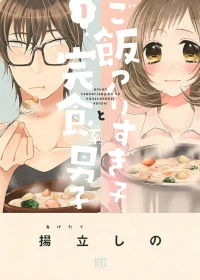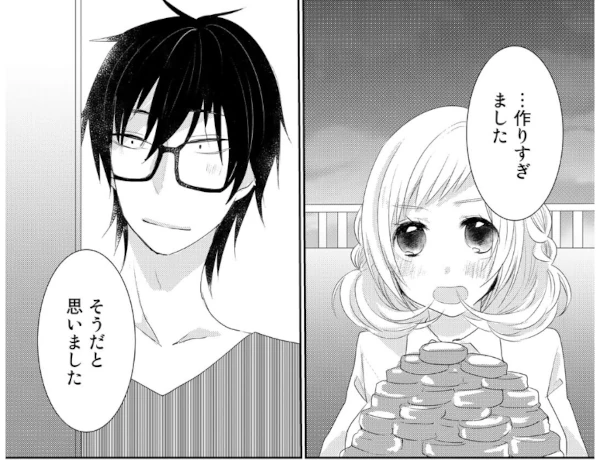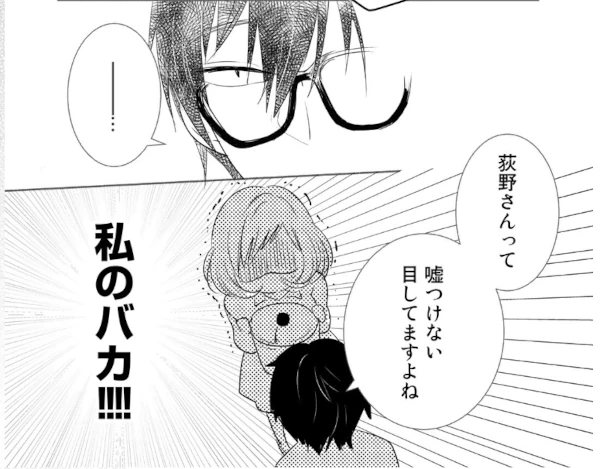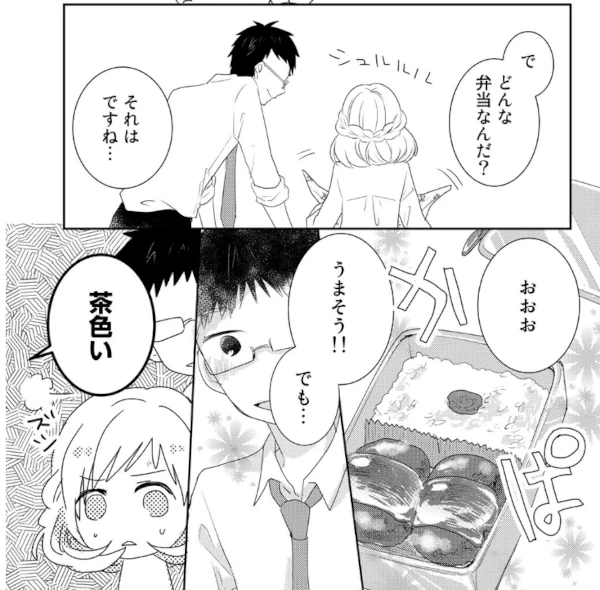This time, we’re introducing Gohan Tsukurisugiko to Kanshokukei Danshi—a manga full of polite conversations and heartwarming moments, ideal for Japanese language learners at any level.
Work Information

Gohan Tsukurisugiko to Kanshokukei Danshi (ご飯つくりすぎ子と完食系男子)
Author: Agetate Shino
Publisher: Gentosha comics
Amount of text: sparse
Challenge level: ★
Latest volume : Vol.12(Sep.2024 / Ongoing)
Story overview
When stress from work builds up, office worker Ogino finds herself cooking way too much. Faced with a pot full of food, she feels overwhelmed, but one day, she comes up with the idea of sharing the extra with her neighbor. However, the university student living next door, Hirase, isn’t exactly warm to her efforts… A food-themed romantic comedy that starts with two neighbors!
The Appeal of This Manga
This heartwarming story gently depicts the growing bond between a woman who always cooks a bit too much and her hungry university student neighbor, with plenty of cozy food scenes along the way. Unlike many typical romance stories, which often rely on misunderstandings, emotional struggles, or dramatic tension, this manga largely avoids those negative tropes (though a hint of them appears now and then, it’s never too serious).
It belongs to the so-called “gentle world” genre, where the focus is on calm, healing moments rather than big ups and downs. Because of this, the story doesn’t aim for high-stakes drama or catharsis, but instead offers a soothing, easygoing experience—perfectly in tune with what many modern Japanese readers seek when they want to relax.
That’s why it’s highly recommended for readers who are looking for a peaceful, feel-good read to unwind with after a long day or for those who love slow-paced slice-of-life romance.

Why this manga is suitable for learning Japanese
This manga is not only entertaining but also highly recommended for Japanese learners for several reasons.
The main characters use polite language in their conversations
Since Ogino and Hirase are just neighbors in the same apartment building and are neither acquaintances nor friends, they always use polite language when speaking to each other. This results in a high percentage of polite speech throughout the story, making it an ideal work for learners of Japanese polite language.

Extremely easy to read
With its relatively low text volume, larger text size, and straightforward content, this story is very easy to follow. Even beginners in Japanese will be able to read through it without much difficulty.

Phrase Spotlight
Fried, Sauced, and Craved: Welcome to Japan’s World of Brown Food茶色い(食べ物)

In recent years, Japanese people have started casually referring to certain types of food as “brown food” (茶色い食べ物). This isn’t an official food category—it’s a fun, informal way of grouping together dishes that tend to be brown in color, high in calories, and incredibly satisfying.
What Counts as “Brown Food”?
These dishes are usually fried, sauced, or stewed—and often loved for their bold flavors. Examples include:
・Karaage (Japanese fried chicken)
・Tonkatsu (deep-fried pork cutlet)
・Hamburg steak
・Grilled meat
・Japanese curry rice
・Beef stew
They may not look very colorful, but they’re packed with flavor—and often associated with home cooking or comfort food.
Loved and Mocked at the Same Time
In Japan, brown food is often talked about with mixed feelings. On the one hand, it’s incredibly popular and considered irresistible. On the other hand, it’s jokingly looked down on or teased, especially on social media, for being unhealthy or visually unappealing when compared to more colorful or health-conscious meals like salads, sashimi, or vegetable-based dishes.
Sometimes, a photo of an all-brown bento (lunch box) will be uploaded to social media with a self-deprecating caption like, “Oops, it’s all brown again!” This reflects both the awareness that brown food is not very photogenic and the fact that, despite knowing it’s fattening, people can’t help but crave it.
Sample Conversations
Conversation 1
A: 何食べたの?
B: 茶色いのばっか。うまいけど罪悪感ヤバい。
A: What did you eat?
B: All brown stuff. So good, but I feel guilty.
Conversation 2
A: 体に気をつけてる?
B: 今日は茶色デーって決めた。
A: Watching your health?
B: Today’s my official brown food day.
Conversation 3
A: また茶色いの?
B: だって、おいしいんだもん。
A: Brown food again?
B: I know, but it’s just too good.
The “Dark Power” of Brown Food
This playful cultural view of brown food highlights its magnetic pull—it may not be good for your diet, but it’s hard to say no to. The idea is that even though everyone knows these dishes can lead to weight gain, they still feel comforted and satisfied when eating them. In this way, brown food represents the irresistible side of Japanese home cooking and comfort food culture.
A Little Warning
Hirase’s polite language is somewhat casual
In the story, Hirase is a university student, so his polite language tends to be casual—particularly at the end of sentences. For example, instead of using the more formal です or ます, he often says っす, a relaxed contraction of です that’s common among younger male speakers.
While his tone remains respectful and friendly, this kind of casual politeness isn’t suitable for formal or business contexts. If you’re learning Japanese with the goal of mastering proper keigo (honorific and polite speech), especially for professional situations, it’s best not to model your speech on his style too closely.

You’ve Seen This One Before!

We’ve covered the expression “●●一択” in detail in a previous article—feel free to check it out!
Work Information

Gohan Tsukurisugiko to Kanshokukei Danshi (ご飯つくりすぎ子と完食系男子)
Author: Agetate Shino
Publisher: Gentosha comics
Amount of text: sparse
Challenge level: ★
Latest volume : Vol.12(Sep.2024 / Ongoing)
Here’s a safe and convenient way to purchase Japanese manga.
This Blog’s ConceptIn this blog, we are introducing manga that are not only highly captivating but also ideal for Japanese language learners. Studying Japanese through manga is both fun and effective. Manga allows you to understand the subtleties of keigo (honorifics), teineigo (polite speech), and casual conversation in Japanese. We hope you find works that match your interests and use them to enhance your Japanese learning journey.